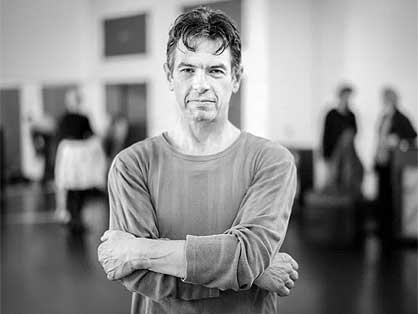
Michael Parmeter is a master raconteur. Not only does the dancer and choreographer tell stories on stage with his body but he’s ready with an anecdote when I ask about his inspiration.
“At the turn of the 19th to 20th century, there was Edgar Degas, the painter, and Stephan Mallarme – a poet at the time.
And Degas met Mallarme at this party and said: ‘Oh, Mr Mallarme I’ve got this wonderful idea for a poem’ and Mr Mallarme said ‘Oh, my dear Monsieur Degas, poems are made of words not of ideas’.
“So I would say that for me it’s not that I have an idea that I then turn into dance,” Parmenter says. “Dance for me comes more as a response to the world.”
In his work Tenerezza, for Language of Living, Parmenter has developed an improvisational duet between dancers Craig Barry and Justin Haiu. It was born from Parmenter’s exploration of new ways to “create a vocabulary of movement that was mine, but the dancers made the movement”.
“So people look at [Tenerezza] and say ‘it’s such a Parmenter piece’ but I sat in the chair all the time, I didn’t make any of the movement and yet it expresses my particular aesthetic and at the same time it expresses the two guys’ [aesthetic] because they made up the movement that they’re doing. I like that sort of democracy of the creativity.”
Language of Living is part of the New Zealand Dance Company’s debut North Island tour (a South Island tour is scheduled for 2014).
Along with Parmenter, the programme is compiled of works from the New Zealand Dance Company’s artistic director Shona McCullagh, Justin Haiu, Sarah Foster-Sproull, Anne Teresa De Keersmaeker and Mark Lorimer (the latter two for Auckland and Wellington only).
The dancers themselves are a mix of established performers and recent graduates, like Lucy Lynch and Gareth Okan.
“One of the primary goals of the company is to create more jobs in the dance sector and provide more reasons for New Zealand dancers with great potential to stay and share their artistry with audiences here,” McCullagh says.
She describes the works in Language of Living as “a mapping of the ways in which dance has – and does – help us understand or articulate the world around us. Whether this is a reflection of nature, social interaction, or the beauty of the architecture of the body in space, our passion is to communicate through the language of the body”.
The tour began last night in Auckland and will travel to Warkworth, Whangarei, Orewa, Hawke’s Bay and Wellington over the next few weeks.
While this is not the first time Tenerezza will tread the boards, it’s the first time Parmenter will see it from the audience.
He began working on the improvisational concept about five years ago before the dance had a showing in a 2010 workshop and then stormed the stage last year for the Auckland-only launch season of Language of Living, which Parmenter missed because he was in Paris working on his doctoral thesis.
Ad Feedback
His research is linked to the relationship between the phenomenon of life and dance which he says ties in nicely with Language of Living. Parmenter explains his idea is about “otherness” and life’s external relationship to the world.
“We tend to think of dance as always coming from the inside out, you know, it’s called expression, and you have the sense of life inside you that you bring out through your movement.
“I didn’t invent the English language, it’s something I had to learn; it was already around. And I can express myself through it but I didn’t make it up, and same with our vocabularies of movement – they are there in the world and we discover ourselves by relating to them.”
Language of Living North Island Tour:
Warkworth: Mahurangi College Hall, May 28, 7.30pm.
Whangarei: Capitaine Bougainville Theatre, Forum North, June 1, 7.30pm.
Orewa: Orewa Arts & Events Centre, June 4, 7.30pm.
Hawke’s Bay: Hawke’s Bay Opera House, Hastings, June 7, 7.30pm.
Wellington: The Opera House, June 12, 7.30pm.
–